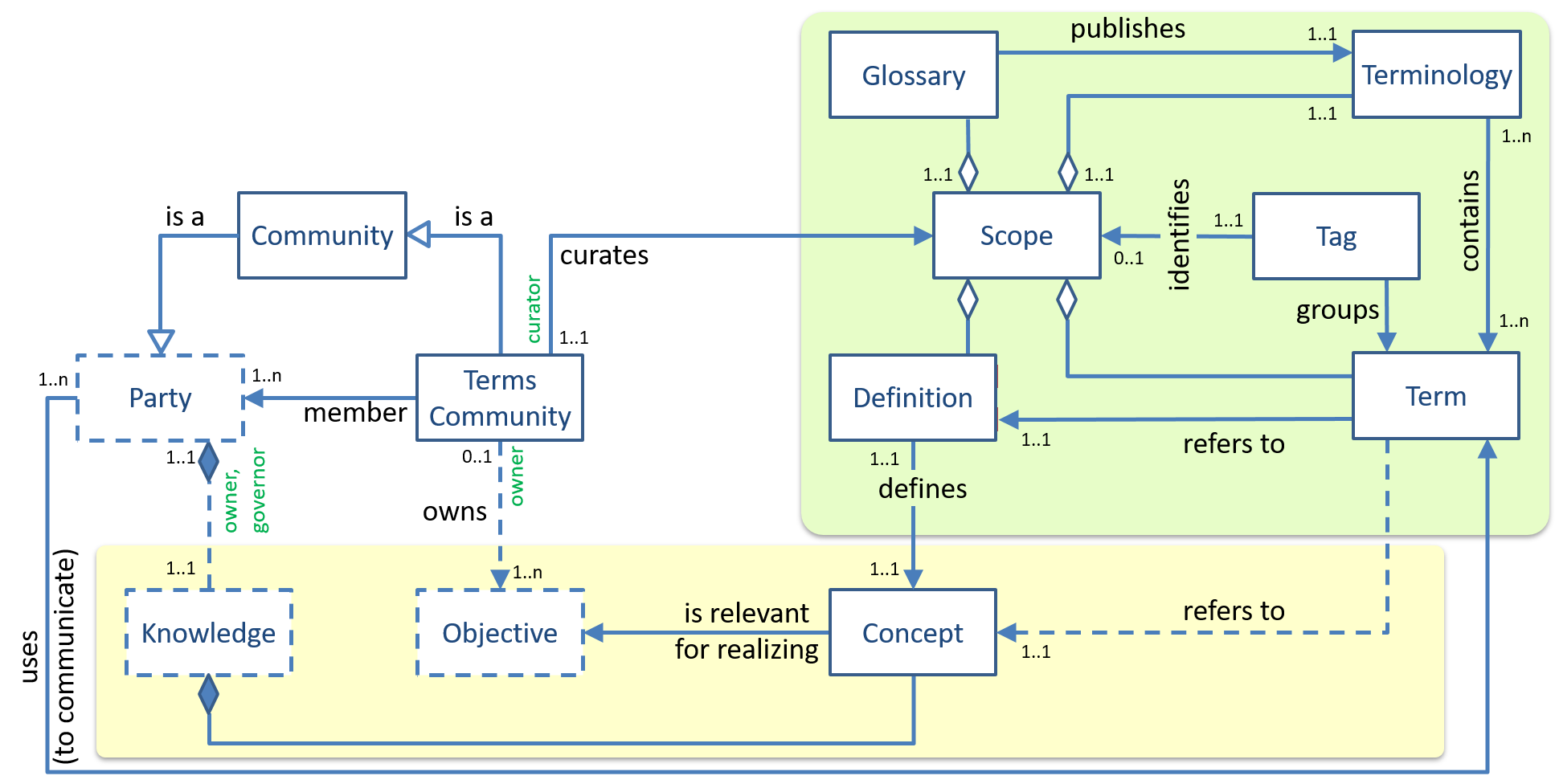Terminology Pattern
Purpose
The idea here is to describe how terms are scoped ('namespaces' is the term used by SW-engineers), how parties govern such scopes/namespaces, and that if you use criteria to define/specify terms, people can test if they have the same understanding of a term by making sure that everyone reaches the same conclusions as they evaluate such criteria in various relevant use-cases.
The prime objective of working with a terminology is to enable individual members of a community to understand the words and phrases that are used by its members in the same, single meaning. This is to say that the differences in the individual understandings of words or phrases by different members of the same community do not pose any problems as they collaborate to serve their shared interests.
This suggests that (members of) a community need the ability and means to (a) establish and maintain (i.e.: own) their own terminology, and (b) to ensure it is fit for the purpose of eliminating such misunderstandings. More concretely, they need the ability and means to create, maintain and improve the definitions that link terms with the concepts/meanings that they agree are relevant for their collaboration, and perhaps also to document the ways of thinking (mental models) that are crucial to their work.
Once a community has its terminology in place, may want to establish an associated glossary that serves as the authoritive reference for the (crucial) terms used by its members. This glossary is also a valuable reference document for a non-community member, as it helps him/her to (better) understand the (verbal or written) communications authored by that community, i.e. it helps to 'map', or 'translate' the terms of that community to words or phrases that the person uses itself, which is prerequisite for effectively engaging with that community.
The secondary objective of working with a terminology is to enable members of ecosystems to establish
- a set of terms that have a 'good definition' (as defined at the end of this document, which basically means that two arbitrary people that use that definition stand a very good chance of having the same individual understanding of what is meant.
- a set of mental models that describe relations and constraints between sets of such terms, thus providing the bases for arbitrary sets of people to have the same understanding of specific ways of thinking about a set of concepts.
Such terminologies and mental models differ from those created for/by communities in the sense that it is basically just a repository of words and phrases that communities may adopt within their own scopes. They have no other authority than what they can derive from being used in/by communities.
The benefit of creating and maintaining such terminologies and mental models lies in the fact that they can be developed with less of a bias of developers than if they were developed in a community (that is there to serve its own interests). As such, they may play an important role as different communities seek to establish a languate for cooperating with one another.
caution
This page has been moved to the eSSIF-Lab Framework on Github.
Introduction
This pattern has two basic parts:
- the management-related part. This part consists of a community that owns its particular set of objectives which exist for establishing cooperation between its members, and for which it needs to establish and maintain, a terminology. Managing, or curating a terminology consists of realizing the objectives that the terminology is intended to serve, i.e. to establish a set of concepts, definitions, terms and mental models, the quality of which is such that
- members of the community use them in the same, single meaning, thereby preventing difficulties in their cooperation, caused by differences in the individual understandings of words or phrases, and
- non non-members of the community can obtain a precise understanding of the communications within that community. Also, this management may cause reference documents to be created and maintained, e.g. a glossary that lists the terminology of the community, a dictionary that includes its terminology as well as terminologies from other, related communities.
- the terminology-related part. This is where concepts, definitions, terms, glossaries etc. live. This part is what one needs to create tools/support for managing and maintaining a terminology. Here, we have concepts with their definitions and terms as a means to refer to either. A concept, its definition live in the same scope, and within that scope there must be a term to refer to that concept and its definition. Within a specific scope, every term is associated with precisely one such concept and definition. However, within a scope, a concept/definition pair may be referred to by multiple terms, which are then synonyms or aliases of each other.
Formalized model
Here is a visual representation of this pattern, using the following notations and conventions:

Editor's note
TNO to provide further introductorty texts